Jinho Choi
Learning Time-Varying Graph Signals via Koopman
Nov 09, 2025Abstract:A wide variety of real-world data, such as sea measurements, e.g., temperatures collected by distributed sensors and multiple unmanned aerial vehicles (UAV) trajectories, can be naturally represented as graphs, often exhibiting non-Euclidean structures. These graph representations may evolve over time, forming time-varying graphs. Effectively modeling and analyzing such dynamic graph data is critical for tasks like predicting graph evolution and reconstructing missing graph data. In this paper, we propose a framework based on the Koopman autoencoder (KAE) to handle time-varying graph data. Specifically, we assume the existence of a hidden non-linear dynamical system, where the state vector corresponds to the graph embedding of the time-varying graph signals. To capture the evolving graph structures, the graph data is first converted into a vector time series through graph embedding, representing the structural information in a finite-dimensional latent space. In this latent space, the KAE is applied to learn the underlying non-linear dynamics governing the temporal evolution of graph features, enabling both prediction and reconstruction tasks.
ConceptScope: Characterizing Dataset Bias via Disentangled Visual Concepts
Oct 30, 2025Abstract:Dataset bias, where data points are skewed to certain concepts, is ubiquitous in machine learning datasets. Yet, systematically identifying these biases is challenging without costly, fine-grained attribute annotations. We present ConceptScope, a scalable and automated framework for analyzing visual datasets by discovering and quantifying human-interpretable concepts using Sparse Autoencoders trained on representations from vision foundation models. ConceptScope categorizes concepts into target, context, and bias types based on their semantic relevance and statistical correlation to class labels, enabling class-level dataset characterization, bias identification, and robustness evaluation through concept-based subgrouping. We validate that ConceptScope captures a wide range of visual concepts, including objects, textures, backgrounds, facial attributes, emotions, and actions, through comparisons with annotated datasets. Furthermore, we show that concept activations produce spatial attributions that align with semantically meaningful image regions. ConceptScope reliably detects known biases (e.g., background bias in Waterbirds) and uncovers previously unannotated ones (e.g, co-occurring objects in ImageNet), offering a practical tool for dataset auditing and model diagnostics.
Hybrid Semantic-Complementary Transmission for High-Fidelity Image Reconstruction
Jul 23, 2025Abstract:Recent advances in semantic communication (SC) have introduced neural network (NN)-based transceivers that convey semantic representation (SR) of signals such as images. However, these NNs are trained over diverse image distributions and thus often fail to reconstruct fine-grained image-specific details. To overcome this limited reconstruction fidelity, we propose an extended SC framework, hybrid semantic communication (HSC), which supplements SR with complementary representation (CR) capturing residual image-specific information. The CR is constructed at the transmitter, and is combined with the actual SC outcome at the receiver to yield a high-fidelity recomposed image. While the transmission load of SR is fixed due to its NN-based structure, the load of CR can be flexibly adjusted to achieve a desirable fidelity. This controllability directly influences the final reconstruction error, for which we derive a closed-form expression and the corresponding optimal CR. Simulation results demonstrate that HSC substantially reduces MSE compared to the baseline SC without CR transmission across various channels and NN architectures.
Low-Complexity Semantic Packet Aggregation for Token Communication via Lookahead Search
Jun 24, 2025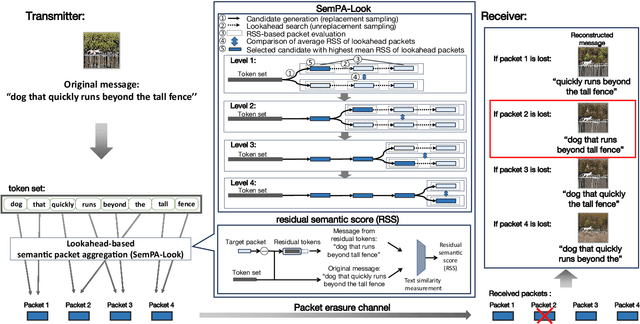
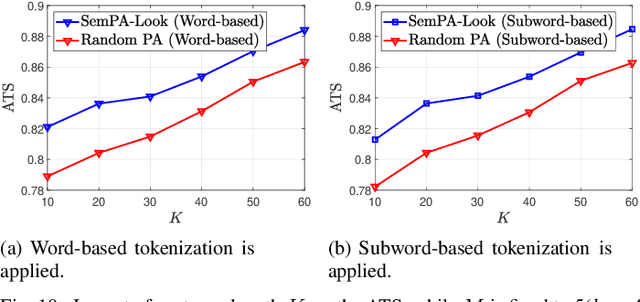
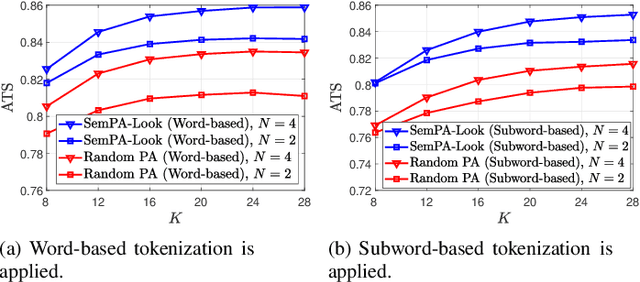
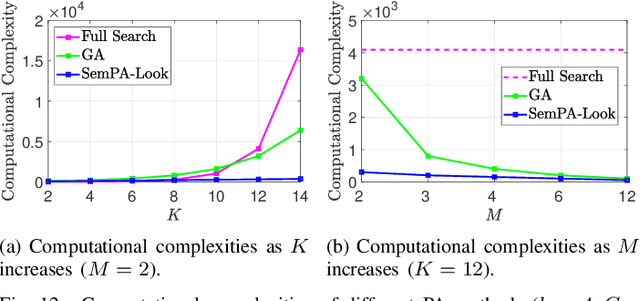
Abstract:Tokens are fundamental processing units of generative AI (GenAI) and large language models (LLMs), and token communication (TC) is essential for enabling remote AI-generate content (AIGC) and wireless LLM applications. Unlike traditional bits, each of which is independently treated, the semantics of each token depends on its surrounding context tokens. This inter-token dependency makes TC vulnerable to outage channels, where the loss of a single token can significantly distort the original message semantics. Motivated by this, this paper focuses on optimizing token packetization to maximize the average token similarity (ATS) between the original and received token messages under outage channels. Due to inter-token dependency, this token grouping problem is combinatorial, with complexity growing exponentially with message length. To address this, we propose a novel framework of semantic packet aggregation with lookahead search (SemPA-Look), built on two core ideas. First, it introduces the residual semantic score (RSS) as a token-level surrogate for the message-level ATS, allowing robust semantic preservation even when a certain token packet is lost. Second, instead of full search, SemPA-Look applies a lookahead search-inspired algorithm that samples intra-packet token candidates without replacement (fixed depth), conditioned on inter-packet token candidates sampled with replacement (fixed width), thereby achieving linear complexity. Experiments on a remote AIGC task with the MS-COCO dataset (text captioned images) demonstrate that SemPA-Look achieves high ATS and LPIPS scores comparable to exhaustive search, while reducing computational complexity by up to 40$\times$. Compared to other linear-complexity algorithms such as the genetic algorithm (GA), SemPA-Look achieves 10$\times$ lower complexity, demonstrating its practicality for remote AIGC and other TC applications.
Communication-Efficient Hybrid Language Model via Uncertainty-Aware Opportunistic and Compressed Transmission
May 17, 2025Abstract:To support emerging language-based applications using dispersed and heterogeneous computing resources, the hybrid language model (HLM) offers a promising architecture, where an on-device small language model (SLM) generates draft tokens that are validated and corrected by a remote large language model (LLM). However, the original HLM suffers from substantial communication overhead, as the LLM requires the SLM to upload the full vocabulary distribution for each token. Moreover, both communication and computation resources are wasted when the LLM validates tokens that are highly likely to be accepted. To overcome these limitations, we propose communication-efficient and uncertainty-aware HLM (CU-HLM). In CU-HLM, the SLM transmits truncated vocabulary distributions only when its output uncertainty is high. We validate the feasibility of this opportunistic transmission by discovering a strong correlation between SLM's uncertainty and LLM's rejection probability. Furthermore, we theoretically derive optimal uncertainty thresholds and optimal vocabulary truncation strategies. Simulation results show that, compared to standard HLM, CU-HLM achieves up to 206$\times$ higher token throughput by skipping 74.8% transmissions with 97.4% vocabulary compression, while maintaining 97.4% accuracy.
Semantic Packet Aggregation for Token Communication via Genetic Beam Search
Apr 28, 2025Abstract:Token communication (TC) is poised to play a pivotal role in emerging language-driven applications such as AI-generated content (AIGC) and wireless language models (LLMs). However, token loss caused by channel noise can severely degrade task performance. To address this, in this article, we focus on the problem of semantics-aware packetization and develop a novel algorithm, termed semantic packet aggregation with genetic beam search (SemPA-GBeam), which aims to maximize the average token similarity (ATS) over erasure channels. Inspired from the genetic algorithm (GA) and the beam search algorithm, SemPA-GBeam iteratively optimizes token grouping for packetization within a fixed number of groups (i.e., fixed beam width in beam search) while randomly swapping a fraction of tokens (i.e., mutation in GA). Experiments on the MS-COCO dataset demonstrate that SemPA-GBeam achieves ATS and LPIPS scores comparable to exhaustive search while reducing complexity by more than 20x.
Semantic Packet Aggregation and Repeated Transmission for Text-to-Image Generation
Mar 31, 2025
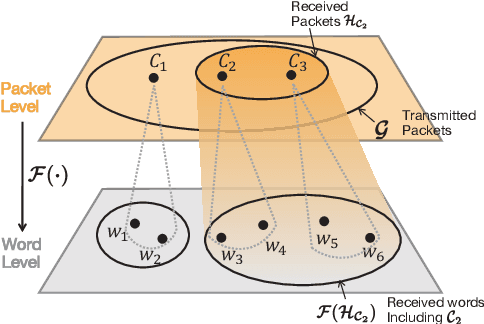
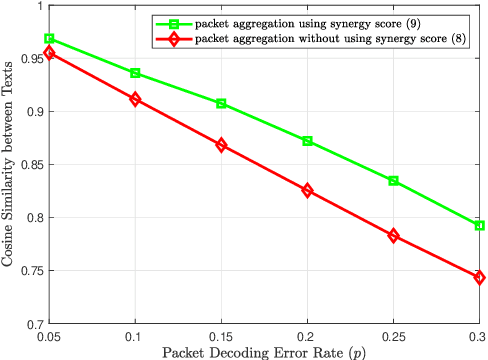
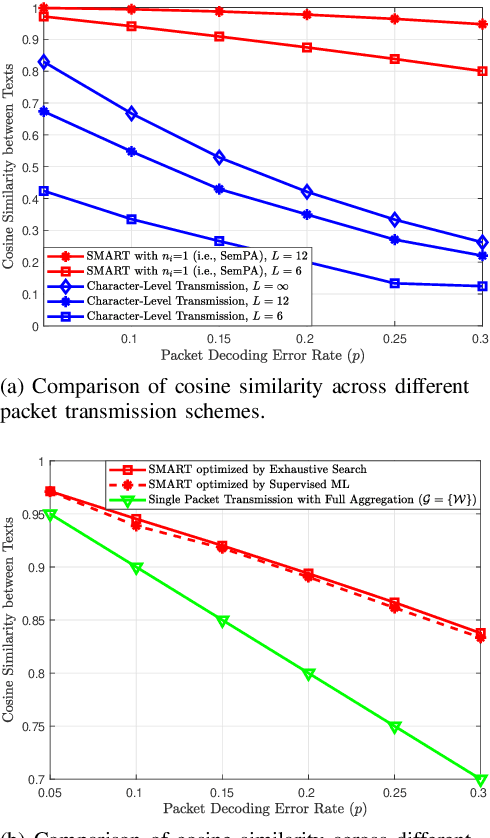
Abstract:Text-based communication is expected to be prevalent in 6G applications such as wireless AI-generated content (AIGC). Motivated by this, this paper addresses the challenges of transmitting text prompts over erasure channels for a text-to-image AIGC task by developing the semantic segmentation and repeated transmission (SMART) algorithm. SMART groups words in text prompts into packets, prioritizing the task-specific significance of semantics within these packets, and optimizes the number of repeated transmissions. Simulation results show that SMART achieves higher similarities in received texts and generated images compared to a character-level packetization baseline, while reducing computing latency by orders of magnitude compared to an exhaustive search baseline.
ScNeuGM: Scalable Neural Graph Modeling for Coloring-Based Contention and Interference Management in Wi-Fi 7
Feb 05, 2025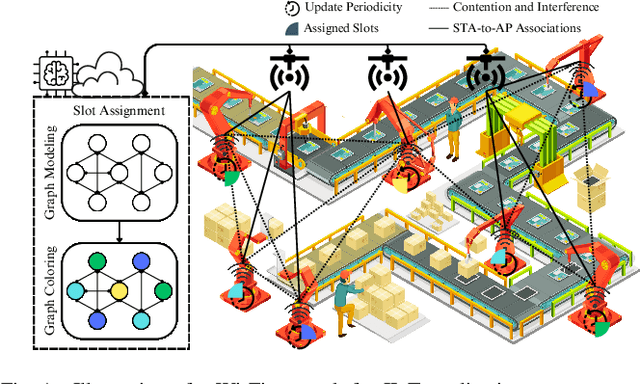
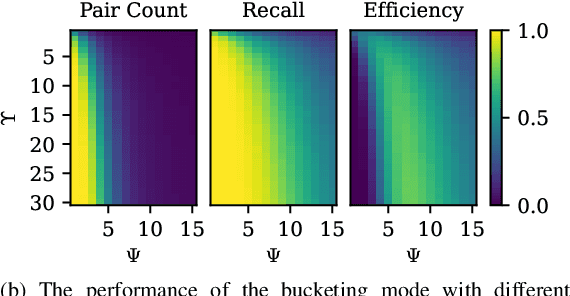
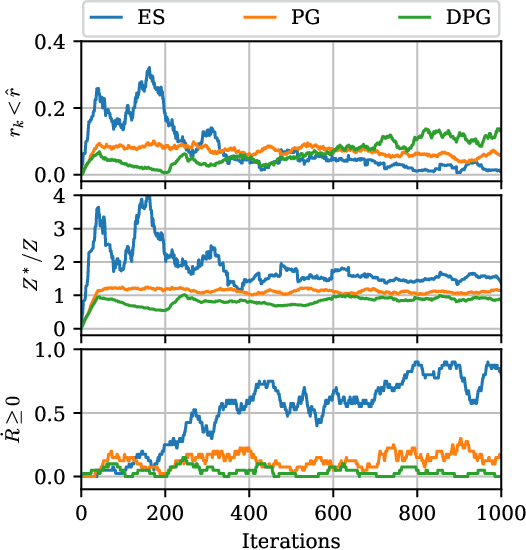
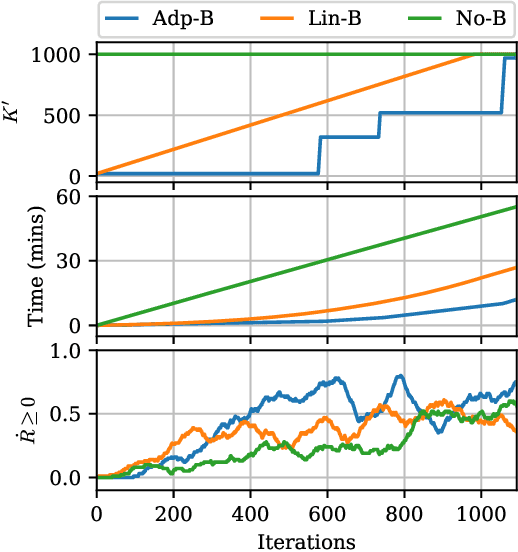
Abstract:Carrier-sense multiple access with collision avoidance in Wi-Fi often leads to contention and interference, thereby increasing packet losses. These challenges have traditionally been modeled as a graph, with stations (STAs) represented as vertices and contention or interference as edges. Graph coloring assigns orthogonal transmission slots to STAs, managing contention and interference, e.g., using the restricted target wake time (RTWT) mechanism introduced in Wi-Fi 7 standards. However, legacy graph models lack flexibility in optimizing these assignments, often failing to minimize slot usage while maintaining reliable transmissions. To address this issue, we propose ScNeuGM, a neural graph modeling (NGM) framework that flexibly trains a neural network (NN) to construct optimal graph models whose coloring corresponds to optimal slot assignments. ScNeuGM is highly scalable to large Wi-Fi networks with massive STA pairs: 1) it utilizes an evolution strategy (ES) to directly optimize the NN parameters based on one network-wise reward signal, avoiding exhaustive edge-wise feedback estimations in all STA pairs; 2) ScNeuGM also leverages a deep hashing function (DHF) to group contending or interfering STA pairs and restricts NGM NN training and inference to pairs within these groups, significantly reducing complexity. Simulations show that the ES-trained NN in ScNeuGM returns near-optimal graphs 4-10 times more often than algorithms requiring edge-wise feedback and reduces 25\% slots than legacy graph constructions. Furthermore, the DHF in ScNeuGM reduces the training and the inference time of NGM by 4 and 8 times, respectively, and the online slot assignment time by 3 times in large networks, and up to 30\% fewer packet losses in dynamic scenarios due to the timely assignments.
SIG-SDP: Sparse Interference Graph-Aided Semidefinite Programming for Large-Scale Wireless Time-Sensitive Networking
Jan 20, 2025



Abstract:Wireless time-sensitive networking (WTSN) is essential for Industrial Internet of Things. We address the problem of minimizing time slots needed for WTSN transmissions while ensuring reliability subject to interference constraints -- an NP-hard task. Existing semidefinite programming (SDP) methods can relax and solve the problem but suffer from high polynomial complexity. We propose a sparse interference graph-aided SDP (SIG-SDP) framework that exploits the interference's sparsity arising from attenuated signals between distant user pairs. First, the framework utilizes the sparsity to establish the upper and lower bounds of the minimum number of slots and uses binary search to locate the minimum within the bounds. Here, for each searched slot number, the framework optimizes a positive semidefinite (PSD) matrix indicating how likely user pairs share the same slot, and the constraint feasibility with the optimized PSD matrix further refines the slot search range. Second, the framework designs a matrix multiplicative weights (MMW) algorithm that accelerates the optimization, achieved by only sparsely adjusting interfering user pairs' elements in the PSD matrix while skipping the non-interfering pairs. We also design an online architecture to deploy the framework to adjust slot assignments based on real-time interference measurements. Simulations show that the SIG-SDP framework converges in near-linear complexity and is highly scalable to large networks. The framework minimizes the number of slots with up to 10 times faster computation and up to 100 times lower packet loss rates than compared methods. The online architecture demonstrates how the algorithm complexity impacts dynamic networks' performance.
Digital Deep Joint Source-Channel Coding with Blind Training for Adaptive Modulation and Power Control
Jan 04, 2025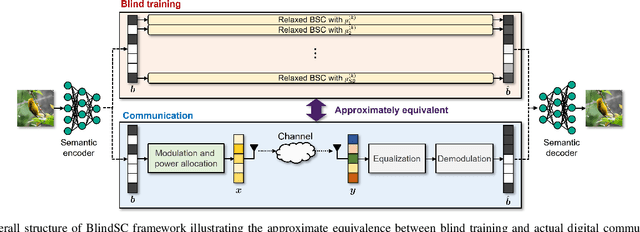
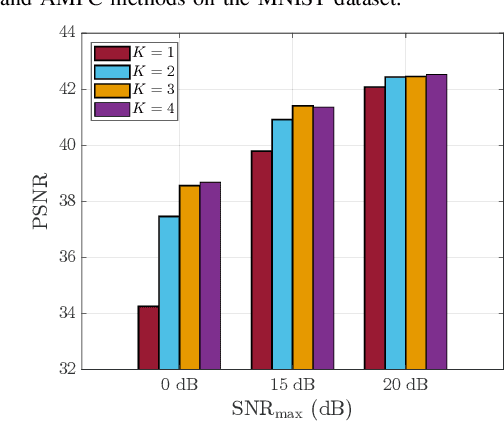
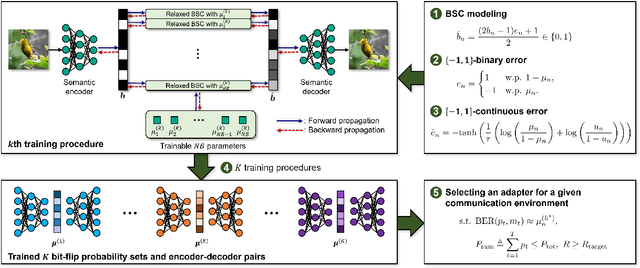
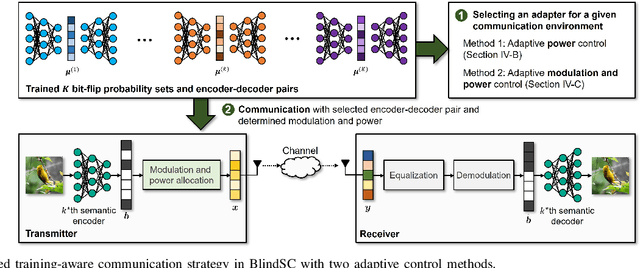
Abstract:This paper proposes a novel digital deep joint source-channel coding (DeepJSCC) framework that achieves robust performance across diverse communication environments without requiring extensive retraining and prior knowledge of communication environments. Traditional digital DeepJSCC techniques often face challenges in adapting to various communication environments, as they require significant training overhead and large amounts of communication data to develop either multiple specialized models or a single generalized model, in pre-defined communication environments. To address this challenge, in our framework, an error-adaptive blind training strategy is devised, which eliminates the need for prior knowledge of communication environments. This is achieved by modeling the relationship between the encoder's output and the decoder's input using binary symmetric channels, and optimizing bit-flip probabilities by treating them as trainable parameters. In our framework, a training-aware communication strategy is also presented, which dynamically selects the optimal encoder-decoder pair and transmission parameters based on current channel conditions. In particular, in this strategy, an adaptive power and modulation control method is developed to minimize the total transmission power, while maintaining high task performance. Simulation results demonstrate that our framework outperforms existing DeepJSCC methods, achieving higher peak signal-to-noise ratio, lower power consumption, and requiring significantly fewer encoder-decoder pairs for adaptation.
 Add to Chrome
Add to Chrome Add to Firefox
Add to Firefox Add to Edge
Add to Edge